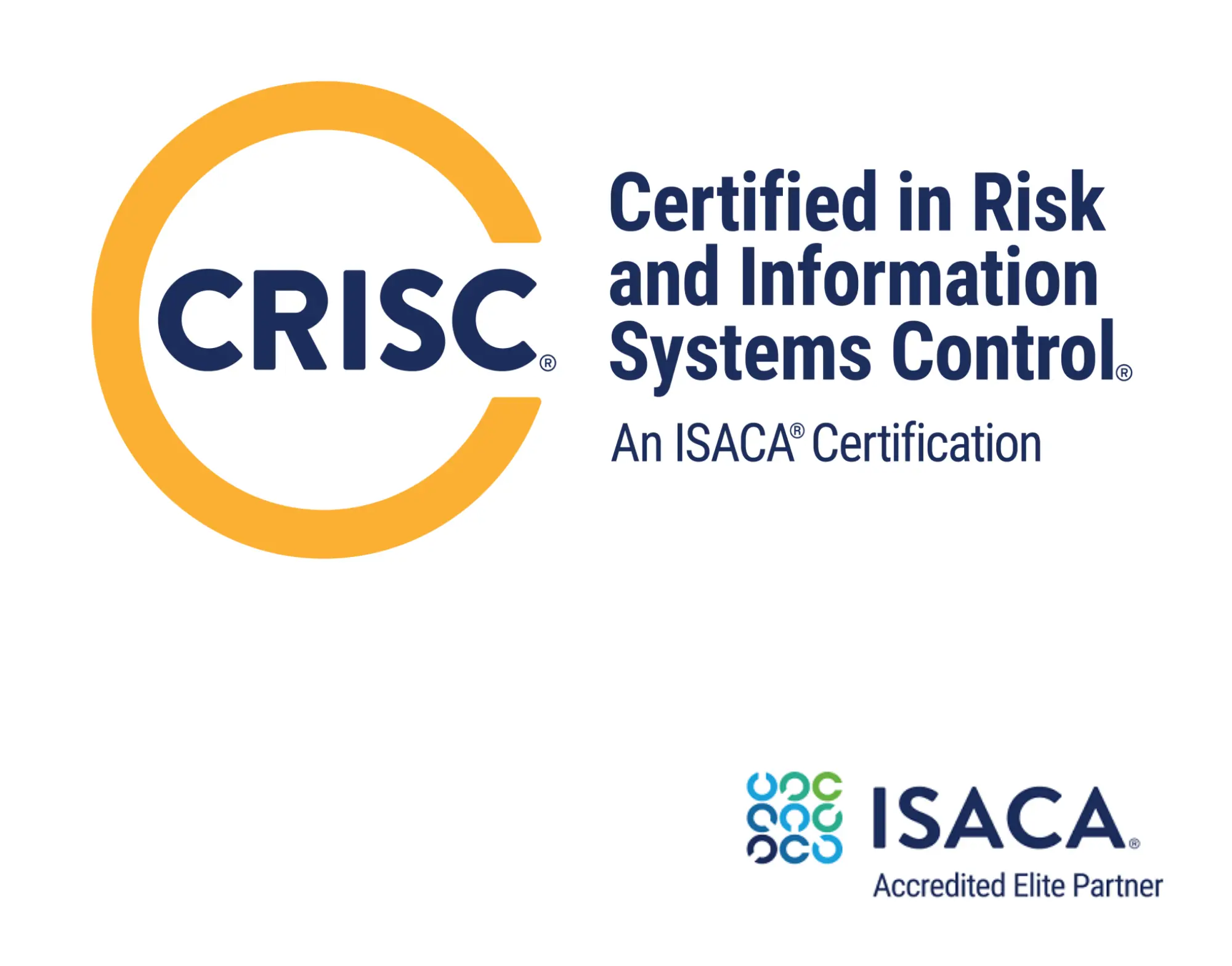Få nye IT-ferdigheter, bli sertifisert og løft IT-karrieren til nye høyder uten å sprenge banken!
Unlimited Taining – IT kurs og sertifiseringer gjort enkelt og utrolig billig. Få tilgang til 60+ Top LIVE-kurs for mindre enn prisen for ett kurs.











course: ISACA CRISC Certification (Certified in Risk and Information Systems Control)
Varighed: 3 days
Format: Virtual or Classroom


Oversikt
Øk karrieren din med ISACA CRISC-sertifiseringseksamenen (sertifisert i risiko- og informasjonssystemkontroll). Få spesialisert opplæring for å mestre risiko- og informasjonssystemkontroll, og bli en sertifisert ekspert. Denne sertifiseringen åpner dører til nye karrierehøyder, og bekrefter dine ferdigheter i å håndtere og redusere risikoer. Meld deg på nå for målrettet opplæring som sikrer at du er godt forberedt til å bestå CRISC-eksamenen og forme en vellykket karriere innen risikostyring.
 Instruktørledet opplæring
Instruktørledet opplæring Practice test
Practice test Selvstudiemateriell
Selvstudiemateriell Personlig læringsplan
Personlig læringsplan Sertifiseringsgaranti
Sertifiseringsgaranti E-mail, chat og telefonsupport
E-mail, chat og telefonsupport









Hvem er kurset rettet mot?
ISACA CRISC-sertifiseringen (Certified in Risk and Information Systems Control) er ment for de som jobber innen risikostyring og kontroll av informasjonssystemer. Den er designet for de som ønsker å validere sine kunnskaper og ferdigheter i å identifisere, vurdere og redusere risikoer for informasjonssystemer i organisasjoner. CRISC-sertifiseringen dekker et bredt spekter av emner knyttet til risikostyring og kontroll av informasjonssystemer, inkludert identifisering og vurdering av risikoer i informasjonssystemer, utvikling og implementering av risikostyringsstrategier, overvåking og rapportering av risikoer i informasjonssystemer, og justering av risikostyring i informasjonssystemer. med organisatoriske mål og mål.
Kursinnhold
Forberedelse
Hos Readynez stiller vi med mange ressurser og har erfarne eksperter på området. Derfor har vi også stor suksess med mange fornøyde kunder. Du kan derfor trygt ta kurset ditt hos oss. For å ta CRISC-kurset kreves det imidlertid noen forkunnskaper.
Du har det perfekte utgangspunktet for å ta dette kurset med disse forutsetningene:
Møt noen av instruktørene du kan møte på kurset ditt. De er eksperter, lidenskapelig opptatt av yrket sitt og dedikert til å gi kunnskapen sin tilbake til industrien, yrket og de som ønsker å lære, utforske og fremme karrieren.

Kevin Henry er en globalt anerkjent ekspert som i over 20 år har bidratt til opplæring og sertifisering av mennesker innen IT-sikkerhet, inkludert CISSP, CISM, CISA og andre.
Kevin Henry is a well-known and highly respected expert instructor with Readynez.
Kevin has served for many years as an authorised instructor for (ISC)2 and he is renowned for his 20-year contribution to learners training for IT security skills- and certifications such as the CISSP, CSSLP, CISM, CISA and CCSP everywhere in the world.
Kevin is a force to be reckoned with, being an authorised instructor and training no less than 9.000 online learners monthly in the fields of information security and audit, in addition to the many students that attend his instructor-led courses with Readynez
He is also one of the most highly-rated instructors and most often he is given scores of 10/10 by his students with comments like these:
“Fantastic teaching and coaching”
Fredrik Palmquist Orange
“Most Excellent educator”
Jens Johanson Trafikverket

James Rowney er en velkjent ekspert med over 20 års bidrag til opplæring av IT-sikkerhetsferdigheter.
James has worked on many large mission critical environments in some of the largest companies in their industries.
Understanding business requirements and drivers are essential to any strategy and design. Understanding environments are key to any application or infrastructure changes, both the immediate services they interface with and those beyond. A failure to satisfy Non Functional Requirements can not be fixed by a process.
Specialties: CISSP, CCSP, AWS Solution Architect Associate, TOGAF 9 certified 86080 member of The Association of Enterprise Architects (AEA) - 27519830. BCS Solution & Enterprise Architect Certified - AMBCS - 990529878, Linux RHCE V5 expired, RHCVA Unix, Storage, SAN, Netbackup, Clusters, Design and Delivery of Infrastructure.

Friedhelm har mer enn 30 års erfaring innen IT, sikkerhet og personvern som senior informasjonssikkerhetskonsulent.
Friedhelm Düsterhöft is a Senior Information Security Consultant, Auditor, Trainer and Managing Director, and has 30+ years of work experience in IT, Information Security and Data Privacy.
He has contributed to various PECB whitepapers and articles, such as ’Information Security in Banks and Financial Institutions’, ‘What Does SIEM Stand For?’, ‘Why Organizations Fail to Pass an Audit’ and “How to Integrate ISO/IEC 27032 Cybersecurity with ISMS?’.
FAQ
ISACA CRISC-sertifiseringen (Certified in Risk and Information Systems Control) er en globalt anerkjent legitimasjon designet for fagfolk som administrerer og overvåker bedriftens risikostyring og informasjonssystemkontroll. Den validerer ekspertise i å identifisere og administrere IT-relaterte risikoer, implementere informasjonssystemkontroll og sikre samsvar mellom forretningsmål og risikostyringsstrategier. CRISC-sertifisering forbedrer karrieremuligheter for personer involvert i risikostyring, IT-kontroll og styring.
Styrk din karriere med Readynez sitt spesialiserte kurs for ISACA CRISC (Certified in Risk and Information Systems Control) eksamen. Få ferdighetene som trengs for å navigere i det komplekse landskapet med risikostyring og informasjonssystemkontroll. Vår ekspertledede opplæring sikrer at du er godt forberedt til å bestå CRISC-eksamenen og bli en sertifisert profesjonell. Bli med Readynez og lås opp muligheter til å utmerke seg innen risikostyring.
For å kvalifisere for CRISC, må du ha 3 års erfaring med risikostyring og informasjonssystemkontroll i løpet av de siste 10 årene etter innsendingsdatoen for søknaden.
Utgiftene forbundet med å oppnå ISACA CRISC-sertifisering inkluderer eksamensavgifter (som varierer fra $575 til $760 for ISACA-medlemmer og $760 til $965 for ikke-medlemmer), studiemateriell (som offisielle CRISC-gjennomgangsmanualer og online praksisspørsmål), og mulige opplæringskurs eller workshops for forberedelse.
ISACA CRISC-eksamensplanen utforsker fire viktige domener innen risikostyring og informasjonssystemkontroll. Kandidatene fordyper seg i risikoidentifikasjon, vurderer sannsynlighet og virkning, utvikler effektive reaksjoner og avbøtende strategier og overvåker/rapporterer risiko og kontrolleffektivitet. Denne omfattende eksamen sikrer ferdigheter i å navigere i det komplekse landskapet av risiko, og forbereder enkeltpersoner til å utmerke seg i roller som involverer risikostyring og informasjonssystemkontroll.
Ja, ISACA CRISC-sertifiseringen (Certified in Risk and Information Systems Control) øker karrieren din betydelig. Globalt anerkjent, validerer den ekspertisen din i å håndtere IT-relaterte risikoer og implementere robust informasjonssystemkontroll. CRISC øker faglig troverdighet, og åpner for ulike karrieremuligheter innen risikostyring, IT-styring og kontroll av informasjonssystemer.
Tiden det tar å bli ISACA CRISC (Certified in Risk and Information Systems Control) sertifisert kan variere avhengig av faktorer som din eksisterende kunnskap, erfaring og tiden du kan dedikere til forberedelse. Generelt kan kandidater bruke flere uker til noen måneder på å forberede seg til eksamen gjennom selvstudier, opplæringskurs og praktisk erfaring.
ISACAs CRISC-sertifiseringseksamener er datamaskinbaserte og administreres ved autoriserte PSI-testsentre globalt eller som fjernkontrollerte eksamener. CRISC-eksamenregistrering er kontinuerlig, noe som betyr at kandidater kan registrere seg når som helst, uten begrensninger.
Vanskelighetsgraden til ISACA CRISC (Certified in Risk and Information Systems Control) eksamen kan variere avhengig av nivået på erfaring, kunnskap og forberedelse. CRISC-eksamenen er utformet for å vurdere ferdigheter i risikostyring og informasjonssystemkontroll, og den dekker omfattende domener. For personer med en sterk bakgrunn innen risikostyring og informasjonssystemkontroll, kan grundig forberedelse og praktisk erfaring gjøre eksamen mer håndterlig.
Kandidater må oppnå minst 450 for å bestå eksamen. CRISC-sertifiseringskomiteen til ISACA har definert et minimalt kunnskapskriterium på 450 poeng.
ISACA krever at sertifiserte personer, inkludert de med sertifiseringen Certified in Risk and Information Systems Control (CRISC), engasjerer seg i videreutdanning (CPE)-aktiviteter for å opprettholde sertifiseringen. CPE-aktiviteter bidrar til å sikre at sertifiserte fagfolk holder seg oppdatert på industriens praksis.
Anmeldelser

Readynez er den beste treningsleverandøren jeg har brukt på mange år. Kundeservicen deres er førsteklasses, prisene er veldig konkurransedyktige og instruktørene er utmerket.

Lett å delta over Teams og en utmerket instruktør ga meg stor verdi for tiden jeg investerte.
Hvorfor Betale Mer?
Hvorfor nøye seg med bare ett sertifiseringskurs når du kan delta på ALLE sertifiseringskurs til en pris som er lavere enn prisen på ett kurs?

Den perfekte måten for oss å utvikle ferdighetene vi trenger for å lykkes
![]() Kasper Meyer Christensen
Kasper Meyer Christensen
Bedrifter som bruker Unlimited Training sparer minst 50 % på opplæring og sertifiseringer – og mange opptil 80 %
Personer med en Unlimited Training lisens gjennomfører i gjennomsnitt 2,4 kurs per år

For en pris som er mindre enn prisen for ett kurs.

Bare billigere og mer fleksibel.

Den enkleste, mest fleksible og billigste måten å bli sertifisert på.

Delta på så mange kurs du vil – ingen begrensninger!

Vi refunderer hvis kostnaden for lisensen overstiger verdien av treningen din.

1-til-1 med 50+ erfarne instruktører

